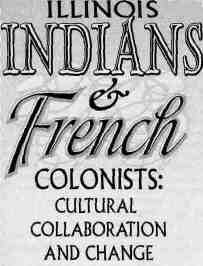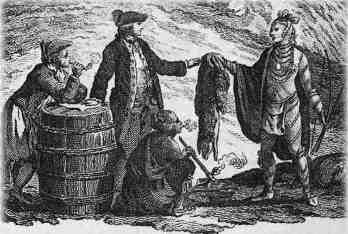
Historical Research and Narrative
When French explorers, fur traders, and missionaries ventured into the Illinois Country during the late 1600s, they entered a land well-populated with Native American people. The Illinois Indians, composed of a dozen affiliated tribes, were a power to be reckoned with in the central Mississippi River Valley. As members of the two societies met and interacted, they saw opportunity in one another. The French had visions of economic development and colonial expansion along the Mississippi. The Illinois sought sophisticated weapons needed to defend their villages from attacks by hostile tribes.
With these incentives, a cultural collaboration emerged that would endure for nearly a century. Both societies native and newcomer changed during the period of interaction. So did the cultural relationship between them. The collaboration was built on three cornerstones: economy, military, and religion. The Illinois and the French became co-dependent trade partners and military allies, while at the same time the French sought to "civilize" the Illinois by converting them to Christianity. These interactions spawned changes in other aspects of life, including technology, settlement, marriage, and population size. The effects of collaboration were uneven in the sense that the Illinois changed to a greater degree than did the French colonists. However, both societies were affected in important ways.
It is difficult to say exactly when the collaboration began. The Illinois and the French were cognizant of one another decades before they actually met. Samuel de Champlain, the explorer who has been called the "Father of New France," took baby steps toward the Illinois when he began charting the St. Lawrence River valley and the eastern Great Lakes in the early 1600s. Champlain also initiated the French fur trade. Animal skins, especially beaver, were in great demand in Europe. Champlain sent itinerant fur traders coureurs de bois to travel among the Indians exchanging French trade goods for pelts. When beaver populations were depleted in the St. Lawrence trapping grounds, traders sought new suppliers among the pays d'en haut or "upper-country" tribes of the Great Lakes.
In 1634 multilingual fur trader Jean Nicollet became the first Euro-American to see Lake Michigan. While visiting a Winnebago Indian village in the Green Bay region, he sought information on undocumented Indians who lived beyond that point to the west and south. Among the groups reported by Nicollet and his successors was a large nation living well south of Green Bay called "Eriniouai," "Liniouek," or "Aliniouek," names signifying the Illinois or Illiniwek Indians.

French Traders and Their American Indian Trading Partners Exchanging European Goods for Furs. Decorative detail from Map of the inhabited part of Canada, from the French surveys engraved by William Faden, 1777. Courtesy of the Library of Congress, Geography and Map Division (G1105.F22 1777).
